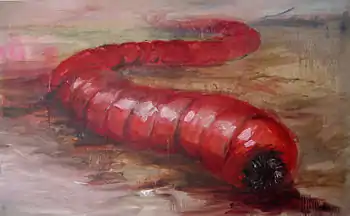Mongolian death worm
The Mongolian death worm (Mongolian: олгой-хорхой, olgoi-khorkhoi, "large intestine worm") is a creature alleged to exist in the Gobi Desert.
.JPG.webp)

The creature first came to Western attention as a result of Roy Chapman Andrews's 1926 book On the Trail of Ancient Man. The American paleontologist described second-hand tales of the monster that he heard at a gathering of Mongolian officials: "None of those present ever had seen the creature, but they all firmly believed in its existence and described it minutely."[1]
In 1983 a specimen of Tartar sand boa (Eryx tataricus) was shown to locals who claimed to have seen "olgoi-khorkhoi" and they confirmed that this was the animal they called "olgoi-khorkhoi".[2][3]
Appearance
In On the Trail of Ancient Man, Andrews cites Mongolian Prime Minister Damdinbazar, who in 1922 described the worm:
It is shaped like a sausage about two feet long, has no head nor leg and it is so poisonous that merely to touch it means instant death. It lives in the most desolate parts of the Gobi Desert.
In 1932, Andrews published this information again in the book The New Conquest of Central Asia, adding: "It is reported to live in the most arid, sandy regions of the western Gobi." Andrews, however, did not believe in the creature's existence.
The worm is said to inhabit the western[4] or southern[5] Gobi. In the 1987 book Altajn Tsaadakh Govd, Ivan Mackerle described it as travelling underground, creating waves of sand on the surface which allow it to be detected.[6] It is said it can kill at a distance, either by spraying a venom at its prey or by means of electric discharge.[5][7] It primarily lives and burrows underground, only rarely coming to the surface.[5]
Investigations
- In 1990 and 1992, Ivan Mackerle led small groups of companions into the Gobi Desert to search for the worm. Inspired by Frank Herbert's novel Dune, in which giant fictional sandworms could be brought to the surface by rhythmic thumping, Mackerle constructed a motor-driven "thumper" and even used small explosions to try to find it.[6]
- In 2005, zoological journalist Richard Freeman of the Centre for Fortean Zoology mounted an expedition to hunt for the death worm but came up empty-handed. Freeman's conclusion was that the tales of the worm's powers had to be apocryphal, and that reported sightings likely involved an unknown species of worm lizard or amphisbaena.[8]
- Reality-television series Destination Truth conducted an expedition from 2006–2007.
- A New Zealand television entertainment reporter, David Farrier of TV3 News, took part in an expedition in August 2009[8][9][10] but came up empty-handed as well.[11] He conducted interviews with locals claiming to have seen the worm and mentioned on his website that the sightings peaked in the 1950s.
References
- Andrews, Roy Chapman (1926). On The Trail Of Ancient Man.
- Ах, Гоби! Путешествие по Монголии в поисках легенды
- Кузьмин С.Л., Дунаев Е.А., Мунхбаяр Х., Мунхбаатар М., Оюунчимэг Ж., Тэрбиш Х. Земноводные Монголии. Москва, КМК, 2017, с. 17–18
- Roy Chapman Andrews (1932). The New Conquest of Central Asia: a narrative of the explorations of the Central Asiatic expeditions in Mongolia and China, 1921–1930.
- June 2014, Benjamin Radford 21. "Mongolian Death Worm: Elusive Legend of the Gobi Desert". livescience.com. Retrieved 2021-01-04.
- Dunning, Brian (8 January 2013). "Skeptoid #344: Olgoi-Khorkhoi: The Mongolian Death Worm". Skeptoid. Retrieved 10 February 2015.
- Daniel Harris (2007-06-26). "The Mongolian death worm". Retrieved 2010-01-29.
- Lauren Davis (2009-07-28). "The Hunt for the Mongolian Death Worm Begins Anew". Retrieved 2010-01-29.
- "David Farrier goes on hunt for Mongolian Death Worm" (Video). July 28, 2009. Retrieved January 1, 2010.
- "New Zealanders Embark on Hunt for Mongolian Death Worm". July 27, 2009. Retrieved January 29, 2010.
- "Digitising, the NZPA Report… & photos". January 9, 2009. Archived from the original on May 26, 2010. Retrieved January 1, 2010.
External links
| Wikimedia Commons has media related to Mongolian Death Worm. |